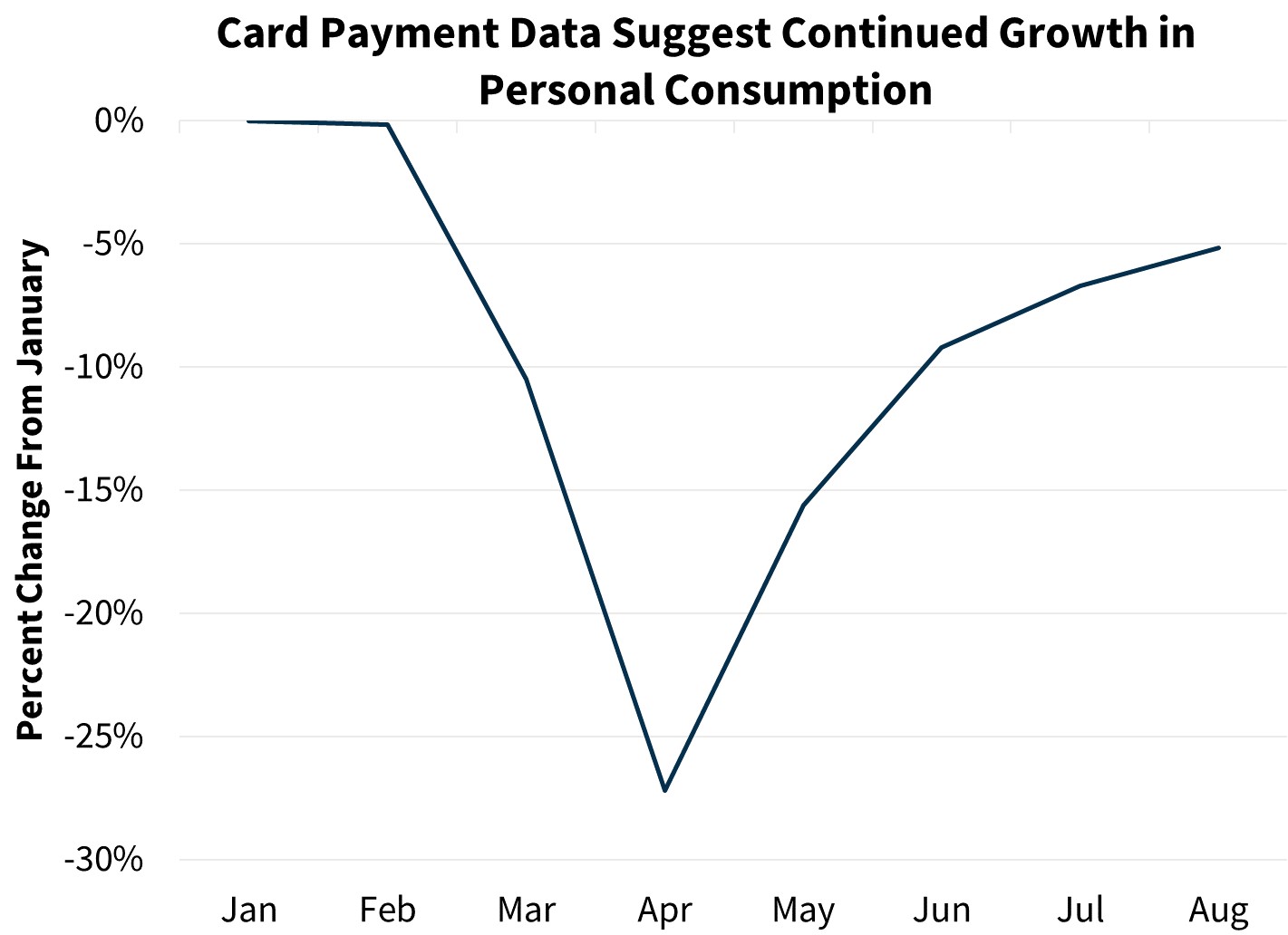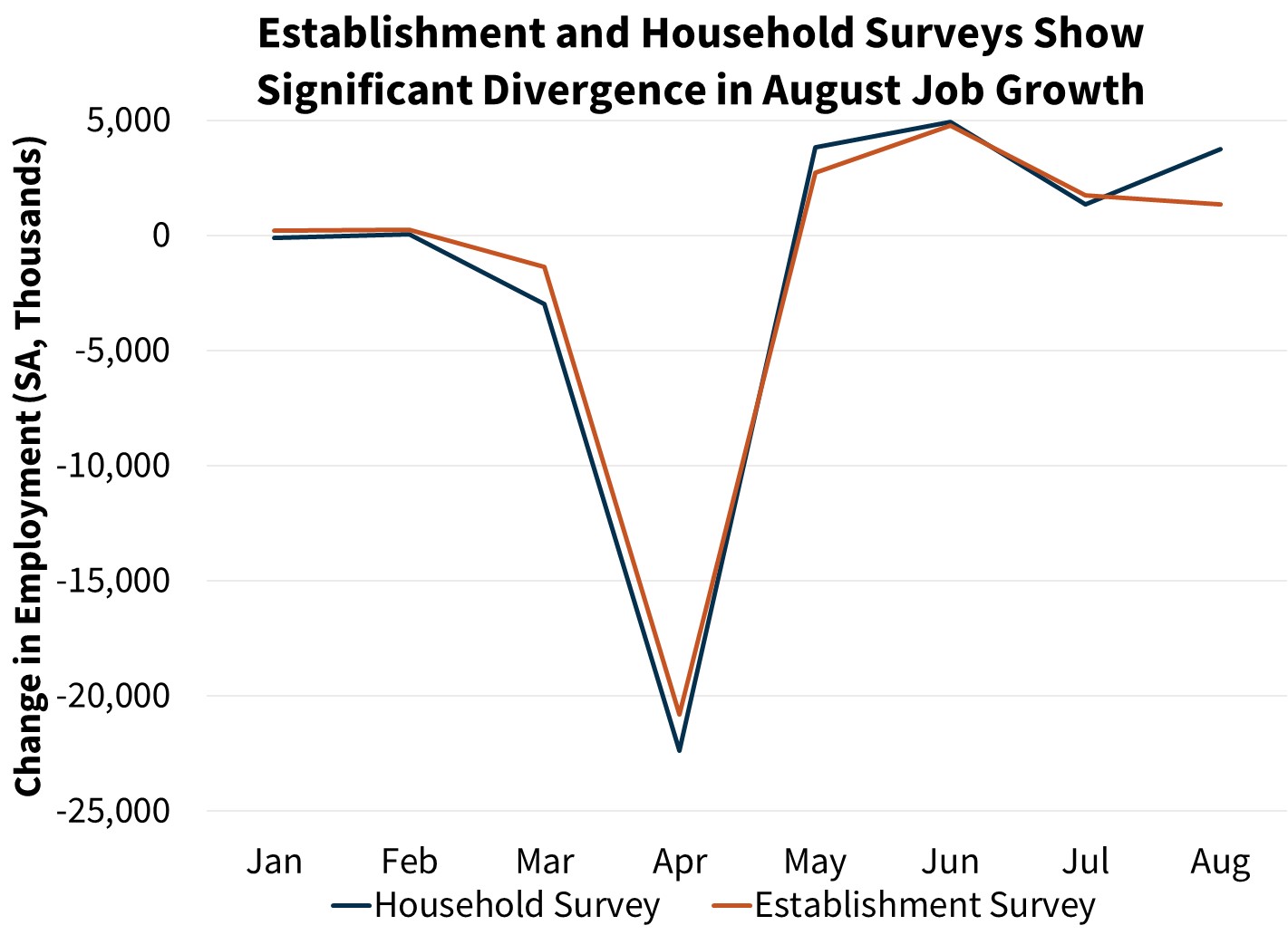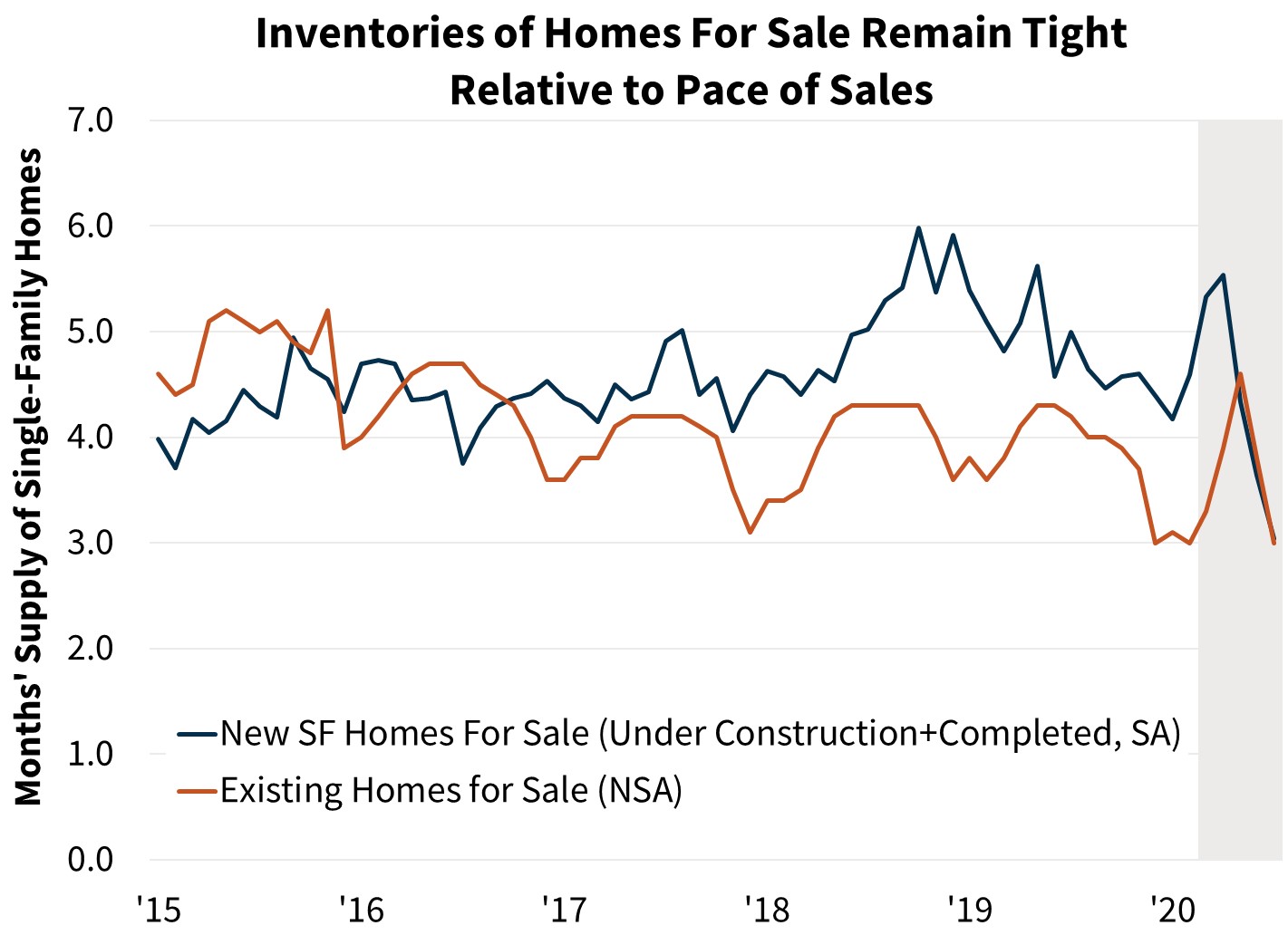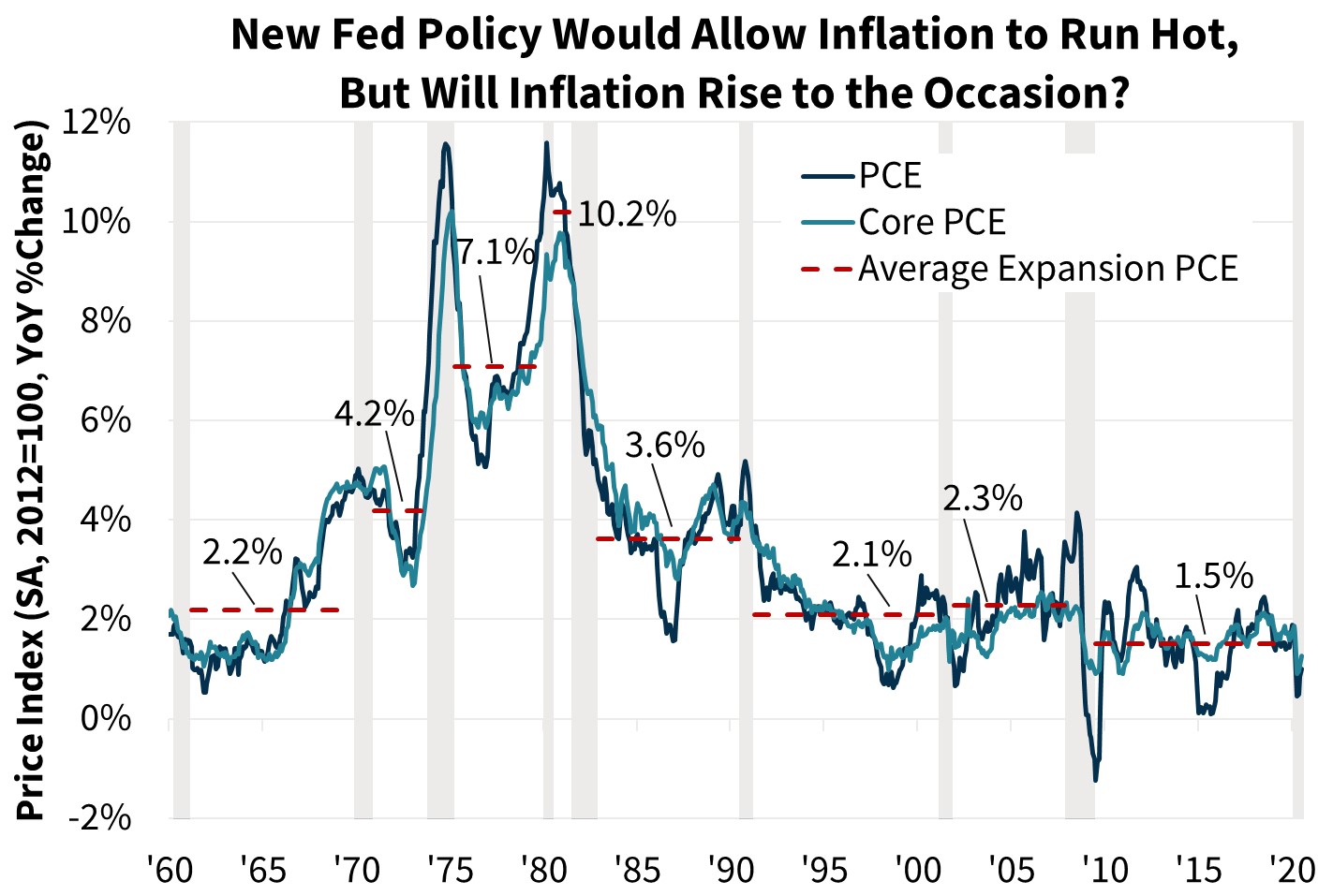Rebound Continues as Housing Helps Lead Recovery
We now expect Q3 real gross domestic product (GDP) to grow at an annualized pace of 30.4 percent, an increase from our August forecast of 27.2 percent. For full-year 2020, we expect a 2.6 percent contraction, an improvement from last month’s forecast of a 3.1 percent decline. While the pace of economic growth has clearly slowed relative to May and June, recent data point to a continued recovery. Real personal consumption expenditures (PCE) posted the third straight month of gains in July, rising 1.6 percent, though this represented a deceleration from 5.7 percent in June.
Last month, we forecast that the July gain in PCE would be followed by a pause in August as the enhanced unemployment benefits expired, before growth resumed later in the year. However, recent data suggest continued growth in consumer spending over the month. Auto sales, an early indicator of PCE, posted another solid gain in August, rising 4.5 percent, and credit and debit card transactions data points to increasing spending as well.

Recent measures of capital goods shipments and construction activity also suggest that business and housing investment will grow at a faster pace in the third quarter than we previously forecast. This expected stronger growth in Q3 indicates a smaller remaining recovery gap. Combined with an updated assumption that there will not be an additional round of stimulus legislation passed prior to the elections, we downgraded our GDP growth estimate for the fourth quarter to 6.2 percent annualized from our prior forecast of 8.7 percent.
Moving into 2021, we continue to assume that behavioral adaptations to the coronavirus will be a factor, limiting the future pace of recovery in some sectors. For instance, we believe hospitality and travel activities are unlikely to return to normal for several years. We expect the pace of growth to decelerate meaningfully in 2021, as recovery in sectors less harmed by social distancing measures nears completion.
Housing data over the past month continued to show a strong “V-shape” rebound, helping drive the broader economy. Existing home sales in July jumped to 5.86 million annualized units, a pace not seen since 2006. While this was in line with our expectations, we previously expected a pullback to follow in August. However, July pending sales, which lead existing home closings by 30-45 days, rose 5.9 percent, and purchase mortgage applications were of a similar magnitude in August as in July. New construction measures also showed strength, with July housing starts hitting the highest level since February. We now forecast residential fixed investment (RFI) in the third quarter to grow 48.7 percent annualized and have substantially upgraded our forecasts for both new and existing home sales. For 2020, total home sales are now expected to be 1.3 percent higher than in 2019. Consistent with this upgrade and continued strength in refinance activity, we upgraded our forecast of mortgage originations in 2020 to $3.87 trillion, which would be the highest nominal dollar annual total since we began tracking the series in 1988.
Heightened Risks to the Outlook Remain
Risks to the forecast remain elevated. As of this writing, COVID-19 cases in the U.S. continue to trend downward, though they are rising again in much of Europe and could spike here as well. Furthermore, if and when vaccines become widely available and utilized will likely affect the path of future consumer behavior. Additionally, uncertainty surrounding fiscal and other policies remains high as the election approaches.
Further downside risks in the coming quarters include a slowdown in global growth and consumer retrenchment in the face of diminished unemployment benefits and the expiration of the Paycheck Protection Program (PPP) loan program. On the other hand, the pace of consumer spending in July remained historically modest compared to income levels. The personal savings rate stood at 17.8 percent. Even with declining unemployment benefits in August, it is likely that the savings rate will continue to be well above the recent pre-coronavirus range of 6 to 9 percent. Combined with extremely supportive monetary policy and continued pent-up demand, significant upside risk is also present. Many households have the means to further drive a consumption demand recovery if they are willing to do so.

Labor Market Measures Paint Mixed Picture, While Business Investment Is Poised for Recovery
The most recent labor market conditions report sent mixed signals on the pace of employment recovery. Payroll employment growth slowed in August but coincided with a sharp drop in the unemployment rate. According to the survey of establishments, 1.4 million jobs were added in August (1.2 million not including the hiring of temporary Census workers). While this pace of growth would be considered strong under normal circumstances, it was a deceleration from 1.7 million jobs added in July. In contrast, the survey of households, from which the unemployment rate is derived, accelerated to a gain of 3.8 million jobs. This translated into a 1.8 percentage point decline in the unemployment rate to 8.4 percent even as the labor force participation rate rose.
While it is not uncommon for the two surveys to diverge, the gap between the measures was the largest in history. The payroll survey is generally considered more reliable month to month, suggesting that the unemployment rate reported in the historically more volatile household survey may rise again even as job growth continues. Additionally, the Bureau of Labor Statistics noted that the response rate in the household survey was lower than normal, which may have introduced additional noise. However, there may be reasons for this divergence beyond statistical noise. The sudden nature of earlier shutdowns and the associated rapid partial recovery thereafter, mixed with the odd combination of subdued services spending and far stronger goods consumption, may be having an unusual effect on the survey sample. Alternatively, many workers supported by PPP loans may have already been counted as employed on the payroll survey in previous months, but only in August when they returned to work did the employees categorize themselves as employed in the household survey.
Acknowledging the uncertainty in current measurement, we have still taken the unemployment improvement as reported; therefore, we have adjusted downward our forecast of the unemployment rate for the remainder of the year. We now predict it to average 7.7 percent in Q4, down from our prior forecast of 8.8 percent. However, our forecast also represents a view of more gradual future payroll employment gains moving into the fourth quarter relative to recent months. If it were the case that recovery in the labor market is indeed bouncing off the coronavirus-induced July softening at a brisker pace, this will likely become more apparent in coming weeks.
Meanwhile, business investment appears poised for a rebound. Core capital goods shipments, a proxy for business equipment spending, rose 2.4 percent in July. Additionally, the August reading of the Institute for Supply Management’s Manufacturing Survey rose 1.8 points to 56.0, above the expansionary threshold of 50 and the highest level since the end of 2018. The National Federation of Independent Business’ Small Business Optimism Index moved up 1.4 points in August, rebounding off a similarly sized decline in July. We now forecast business fixed investment to grow 11.9 percent annualized in the third quarter. Furthermore, data on imports and business inventories suggest that firms may be close to ending a period of destocking. This bodes well for future increases in manufacturing output, which, to date, has lagged the recovery in consumer spending.
Housing Sales Continue to Get Ahead of Supply
July existing home sales rose 24.7 percent over the month and were 8.7 percent higher than a year prior. While further increases of this magnitude are unlikely, the solid increase in July pending sales and strength in purchase mortgage applications suggest a continued brisk pace in the near term. Pent-up demand from the spring, historically low mortgage rates, and what appears to be an increased interest in moving to suburban areas in at least some metro areas is fueling strong home purchase demand.
While the July pace of sales was in line with our expectations, the continued strength in August has exceeded them. Still, we believe the current pace to be unsustainable due to a lack of homes available for sale. New single-family listings have grown modestly on a year-over-year basis, but the growth is much slower than purchase demand. The months’ supply of homes for sale as a ratio of sales fell to 3.1 at the end of July, down 26 percent from a year prior and to the lowest level for the month of July in the history of the series. We revised upward our existing home sales forecast for the remainder of 2020, but we expect sales in the fourth quarter to fall back somewhat compared to the current pace.
The lack of inventory of for-sale homes is putting upward pressure on home prices and threatens to negate the affordability benefits from low mortgage rates. The CoreLogic National House Price Index showed an acceleration in annual house price growth to 5.5 percent in July, up 1.2 percentage points from June. According to Realtor.com, the median listing price was up 10.8 percent from a year prior during the first week of September. While this strong price appreciation could dampen sales going forward, it is likely helping drive upwards the net share of respondents saying it is a good time to sell a home, according to the August reading of Fannie Mae’s Home Purchase Sentiment Index® (HPSI). More owners would have to act on that sentiment and list their homes for the sales pace to continue at its robust rate and alleviate some of the upward price pressure.

Extremely limited inventory of existing for-sale homes will likely continue to bolster demand for new homes. Single-family housing starts rose 8.2 percent in July. This increase was outpaced by new home sales, which jumped 13.9 percent to 901,000 annualized units, the highest level since 2006. Even with a strong recovery in construction, supply is not keeping up with demand. The months’ supply of new homes for sale that had already been started as a ratio of sales fell to 3.0 in July, tying the lowest level since 2004. Homebuilders are expected to accelerate the pace of construction to meet current sales backlogs. Given these conditions, we revised our forecast for both new home sales and housing starts higher. We now expect new single-family housing starts to reach over one million annualized units by the end of the year and for the full-year total to rise 5.1 percent above 2019 levels.
Multifamily housing construction also jumped in July, with starts surging 58.4 percent to 556,000 annualized units. While the series is notoriously volatile, the pace was the second fastest since 1986, only behind January 2020’s best of 628,000 annualized units. The surge likely reflects projects breaking ground that were delayed in the spring during the height of shutdowns. While multifamily construction activity could continue to show strength in coming months as projects currently in the planning pipeline are initiated, we expect multifamily construction activity to be weaker than single-family construction through at least mid-2021. We expect that a shift of some renters to homes in suburban areas and weaker rent growth in class A apartments will likely dampen new projects in many urban locations.
For more on multifamily market conditions please see the September 2020 Multifamily Market Commentary.
Mortgage Originations Revised Upwards as Rates Remain Low
We upgraded our purchase mortgage originations forecast consistent with recent, robust housing data as well as continued strength in acquisitions and securitizations data. We expect purchase originations to grow 8.9 percent in 2020 to $1.4 trillion, $112 billion higher than last month’s forecast. We forecast purchase volumes to grow 3.3 percent in 2021 as decelerating home price growth limits additional volume.
Refinance originations were also revised upward, now totaling $2.4 trillion in 2020, a full $350 billion higher than last month’s forecast. This revision was driven by stronger-than-expected securitization and application activity, though we expect that some of this volume are refinance originations being pulled forward. As a result, we modestly lowered 2021 refinance volumes from last month’s forecast. However, we continue to believe that a low-rate environment will support refinance demand over the forecast horizon. At the current interest rate of 2.86 percent, we estimate that nearly 69 percent of outstanding first-lien loan balances have at least a half-percentage point incentive to refinance.
At 2.86 percent, this represents another all-time low for the 30-year fixed mortgage rate, which averaged a slightly higher 2.94 percent during the month of August. Meanwhile, after starting August at all-time lows, the 10-year Treasury yield increased over 15 basis points during the month, ending at around 0.7 percent. The rise in the 10-year average yield and the slow decline of the mortgage rate led to a compression of the primary mortgage spread (30-year mortgage rate minus the 10-year Treasury yield). The primary spread averaged 229 basis points in August, down from 264 in April, but still well above January’s average of 185 basis points. The pace of compression is expected to slow significantly by the end of the year, keeping spreads elevated but mortgage rates low for at least the next year.

We expect most short-term interest rates to remain low for the foreseeable future given the Federal Reserve’s latest Policy Framework update released at the end of August. The largest change to the Fed’s policies included making the two percent inflation target an average objective, meaning that the Fed will now be comfortable allowing inflation to run above that threshold for a longer period of time. Thus, the Fed is unlikely to raise interest rates to preemptively head off inflation, keeping short-term interest rates lower for longer. The impact on longer-run rates, like the mortgage rate, will depend in part on the Fed’s future management of inflation expectations. There is some skepticism that this new policy will actually produce inflation above two percent, which has failed to materialize consistently for the past decade. The policy review also updated the Fed’s maximum employment objective to be a broad-based and inclusive goal. This suggests that the Fed may not consider any unemployment rate too low, until inflation is clearly realized, due to the social benefits from reduced unemployment for low-income workers. While these policy changes are significant for the future course of monetary policy and inflation expectations, we expect the impact on current Fed policy will be minimal given expected economic conditions over the next few years. The federal funds rate is already near-zero and markets do not believe it will be raised anytime soon.
Economic & Strategic Research (ESR) Group
September 10, 2020
For a snapshot of macroeconomic and housing data between the monthly forecasts, please read ESR’s Economic and Housing Weekly Notes.
Bureau of Economic Analysis, Fannie Mae ESR Group, Bureau of Labor Statistics, Mortgage Bankers Association, National Association of REALTORS®, Census Bureau, National Association of Home Builders.
Opinions, analyses, estimates, forecasts and other views of Fannie Mae's Economic & Strategic Research (ESR) Group included in these materials should not be construed as indicating Fannie Mae's business prospects or expected results, are based on a number of assumptions, and are subject to change without notice. How this information affects Fannie Mae will depend on many factors. Although the ESR group bases its opinions, analyses, estimates, forecasts and other views on information it considers reliable, it does not guarantee that the information provided in these materials is accurate, current or suitable for any particular purpose. Changes in the assumptions or the information underlying these views could produce materially different results. The analyses, opinions, estimates, forecasts and other views published by the ESR group represent the views of that group as of the date indicated and do not necessarily represent the views of Fannie Mae or its management.
ESR Team
ESR Macroeconomic Forecast Team
- Doug Duncan, SVP and Chief Economist
- Eric Brescia, Economist
- Rebecca Meeker, Financial Economist
- Mark Palim, VP and Deputy Chief Economist
- Nick Embrey, Economist
- Richard Goyette, Business Analyst
